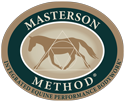“I have a bachelor’s degree, two master’s, a Ph.D. and was a Fulbright Scholar, and this past week was one of the BEST education experiences I have had since my “academic” work began in 1992. I have learned enough to recognize when I need to ask questions.”
~ Beth Watzke
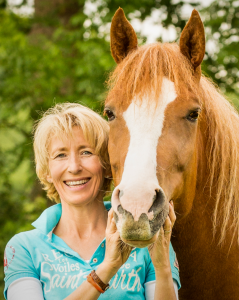
“Jim is doing a great job on all horses and much more important, he is a wonderful teacher for every horse owner to improve performance, communication and our relationship with our trusting friends. Thank you, Jim and Conley for creating the Masterson family with us. It is such an authentic spirit with all the lovely people around the world!”
~ Anja Tack
“I have been incorporating the Masterson Method into my work as a veterinary chiropractor (with both horses and dogs) since 2018. Jim’s methods of working with the horse, using light contact, slow movements, holding contact and waiting on releases from the horse is a beneficial and beautiful way to partner with the horse. I find that incorporating the Masterson Method complements my work and helps the horse’s body to eliminate the muscle imbalances and compensatory fixations caused by underlying subluxations. When the muscle imbalances are reduced, a lower level of physical exertion is required from the practitioner. “When less is more,” it’s a win-win for both horse and veterinary chiropractor!”
~ Robin Robinett, DVM
Veterinary Chiropractic and Rehabilitation Clinic, PC, Houston, Texas
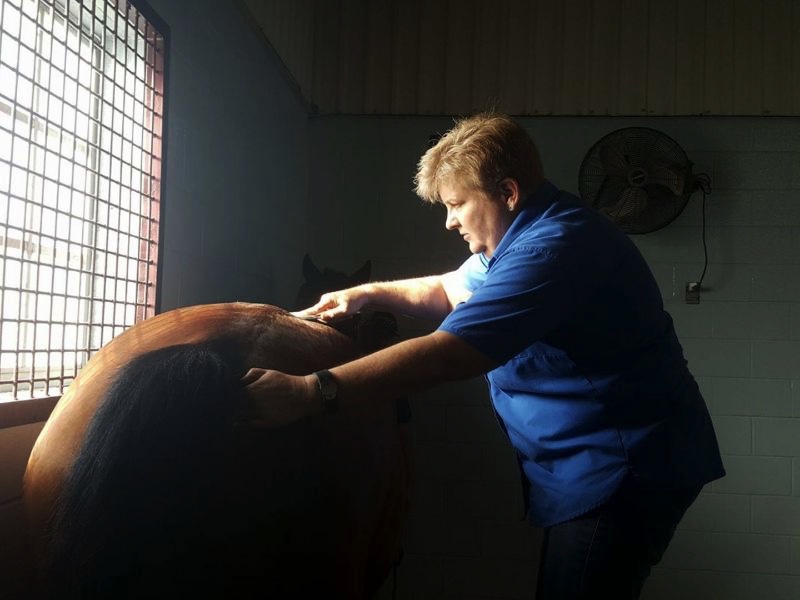
“Every person that I have met on my Masterson journey has expressed the same sentiment regarding how much this work has positively impacted not only their approach to working with horses, but has also contributed to a quieter/gentler approach to life itself.”
~ Jennifer Sechrist
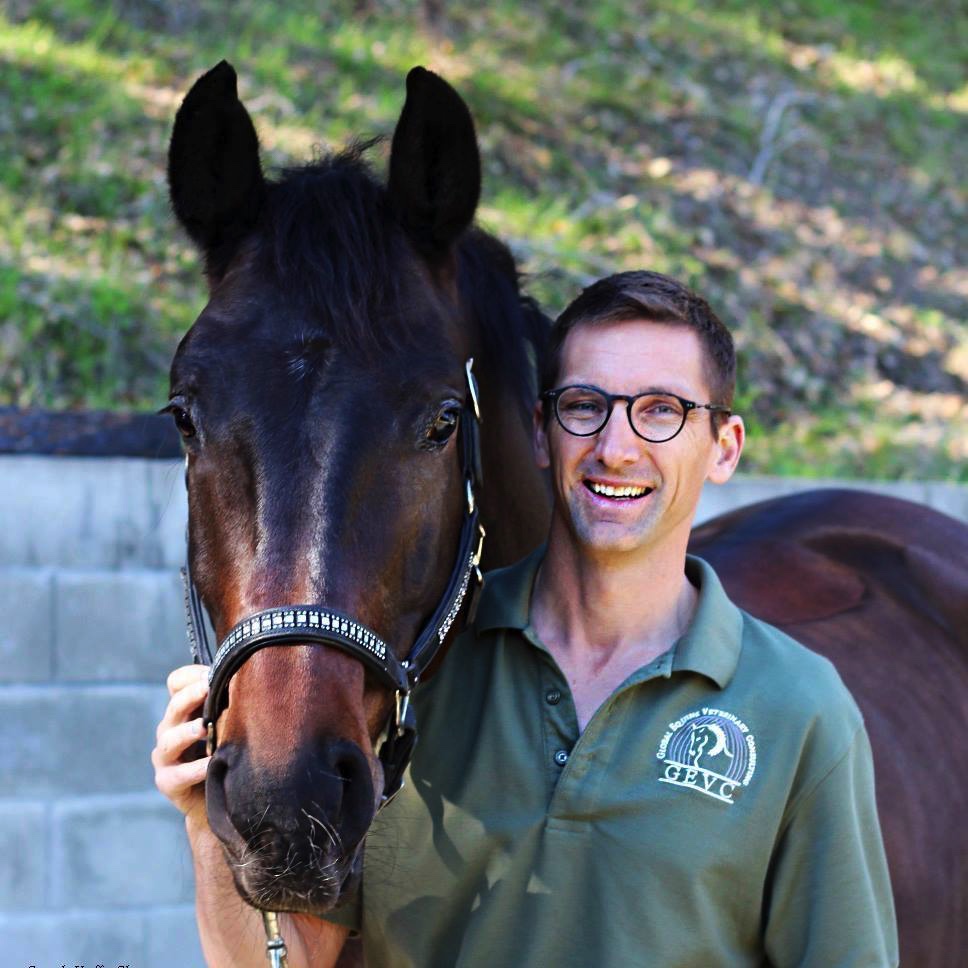
“As a veterinarian focused on equine integrated sports medicine and rehabilitation, I have explored a variety complementary and alternative veterinary medicine approaches in an effort to create and maintain optimal health and performance in horses. One of these approaches is the Masterson Method. I had the opportunity to take one of the weekend seminars and attend one of the collaborative clinics introducing me to this gentle technique.
The beauty of the technique is that (it) can be applied by any horse person and can be incorporated into daily or weekly routines when brushing or caring for the horse, further improving the connection between owner/caretaker and horse. The local and systemic relaxation that you get from the Masterson Method is quite amazing and allows you to get results with even the most difficult horses that may not allow the use of other techniques such as dry needling/acupuncture.
I really like that fact that the certified Masterson therapists are always looking to work in a team with the veterinarian and other equine professionals. Since I took the Masterson seminar, I had the opportunity to work side by side as a veterinarian with certified Masterson therapists on mutual patients with the same goal in mind: improving the health and well-being of the horse.”
~ Bart Halsberghe, DVM, DABVP (Equine practice), cISELP, cVSMT, cVMA, CERT, CKTP-E
Global Equine Veterinary Consulting, Aalter, Belgium
Dear Jim,
I found The Masterson Method last autumn, and emailed you to thank you. I shared in my email about my now 27 year-old Standardbred gelding, who had issues with the Bladder Meridian Technique. He had had stomach issues previous winters, loosing weight, not eating, having gas, colics etc. and seeming depressed… and I feared that he wouldn’t last this winter and considered putting him down.
The veterinarian came to see him, found him otherwise healthy—lungs, heart and legs—and suspected gastric sand. She suggested psyllium treatment, light exercise and warm mash water to ensure he’s drinking enough. Her opinion was that “let’s try this and if problems still appear, then we’ll let him go.”
Okay, we did as doctor ordered. After a few days sand fix treatment (sand coming out where it should) I did the Bladder Meridian with him, and this time he didn’t shy away on that difficult spot, but followed my hand when I tried lifting it higher to ease the pressure, for he was fidgeting quite a lot. It took ages, he was responding by fidgeting, blinking and his ears twitching back and forth, and then he started releasing like crazy. He sighed and yawned and did everything at the same time, almost violently, as if he couldn’t get it fast enough out of his system.
I was afraid that his nervous system was overloading, but if I tried removing my hand, he followed it and continued releasing. I just stood there, stunned, arms aching, and stayed where he asked me to stay. Finally he lowered his head, sighed a long, deep sigh, stretched and stayed still, with soft eyes, looking very relaxed and one could say, happy. When I looked at the mirror afterwards, I looked very stressed, and one could say, very, very shaken. 😉
Since that he hasn’t had issues with the Bladder Meridian Technique. He has gained weight, been eating all his hay, that he is given as much as is consumed. He has practically unlimited access to forage like has been all his life since birth. He hadn’t had any excess intestinal gas, and no colics this far. No symptoms of depression of any kind, he has been his normal high-spirited self during even this darkest period of the year, the leading stallion (in his own mind).
I think that the vet was right, he had gastric sand somewhere in his system. At least quite a lot of sand was coming out during the treatment. My guess is that sand caused him pain and accumulated tension that he wasn’t capable to release. The psyllium treatment removed the sand, he needed to release that long-term tension, and was ready to do it. In a very upsetting manner in my opinion, but this is about him, not me.
Jim, I need to thank you again.
Although the vet’s instructions to remove the sand cured him, I think your method had a significant role in his rehabilitation. I think it is important to notice, that because of the ulcer risk, he wasn’t given any painkillers at all during the process. After this huge bladder meridian release, there wasn’t, and has not been ever since, a slightest symptom of pain left in that horse. I know him so well that I know when he is not feeling well just by looking at his eyes.
This is the horse of my life, and I am not going to keep him alive by any cost for my own sake. When it is time for him to go, it is time, no matter how much it hurts. But I am grateful that he is now able to live a good, healthy life at least a little longer. And I am grateful for this extra time we now have.
I thank you again, for behalf of my senior horse and myself. My warmest regards to everyone at the Materson Method staff.
Kati
“It has changed my life and every horse I’ve been in contact with! Relaxation and relationship… working WITH the horse and using skill with intuition. Amazing results all around! ❤️🐎”
~ Diane Eissler
I have two two Shetland pony mares, 12 and 5 yrs. They are either in training or racing harness racing. We have quite an active harness racing community for ponies here in Finland.
The performance of the elder pony has been varying on the races lately, sometimes her own level, sometimes slow or disqualified without any logic. Finally after the last race her right shoulder got very stiff and muscles on the left loin hot, sore, swollen and tense. I called our vet, and we got an appointment at her clinic 15th of October. We are planning to check her teeth/ mouth, blood values, x-raying her stomach for sand plus of course examining her legs and treating them if necessary.
While waiting to see my Euros fly by I tried cooling arnica gel (works wonders with chronically stiff owner), stretching and massage. The shoulder got much better, but the loin only slightly. I was suspecting harness or the chariot being slanted and tried to lungeing her lightly in canter instead of driving, but her movement went only worse and she refused any further co-operation. I decided I was doing something terribly wrong, and got to my computer doing online search. I watched lots of videos, some of them making me sad and angry for the horses “treated”, some of them showing nothing new, until I stumbled upon your videos about hind release points and using bladder meridian to release pain. Horses looked so content, happy even, while you were working with them, and even more, they seemed to be happy with you, so I tried your method the same day.
I tried the elder pony mare first, and that was really amazing. She was a real schoolbook example for both Bladder Meridian and Hind Release points, straightforward search-response-stay-release. Only point she reacted strongly was her left inner thigh. She bolted and nearly kicked (not me though, she’s not that kind) when I touched the point inside her left knee. I stepped back and tried again, this time barely touching her, and she accepted my touch. After some fidgeting she suddenly dropped her left pelvis, and the whole left hindquarter with a huge sigh and yawn. Then she allowed me to gently palpate the inner thigh, resting her leg relaxed on the tip of her hoof. It turned out that her muscles on the left knee and thigh are smaller, and more tense than on the right, so I guess I finally got near the root cause. Now it’s up to the vet to go on from there.
I have now worked with her Bladder Meridian for two more times, three evenings at the row. The second day when my fingers touched her right side withers, she immediately dropped her left pelvis with a huge sigh, yawning and licking. Today she relaxed her diagonal pelvis already when I started with her neck and reacted to different points only by turning her ears backwards. Not pinning, just listening to what is going on back there. I stayed on each spot as long as her ears were twitching back and forth, slowly lifting my fingers until she sighed / licked. On some spots she turned her head to me, and I gently corrected her neck straight a few times until she pressed her neck against my fingers and I realised she wanted more pressure. OK, I gave her more pressure, and she responded with ears twitching, eyes closing and finally her head going down with a sigh. I went through the Bladder Meridian on both sides, and got to that left inner thigh and knee. She was already relaxing her left hind. I noticed her skin on the left stifle being thick and hard as a plank and not moving at all over the relaxed muscles, so I started to gently move the skin doing slow little rounds with the tip of my fingers. She listened to it, her ears and eyes slightly alarmed, then decided it’s OK. I went with my instincts and placed my both palms softly on her and gently moved a larger area of her skin with slow round movements. After a while she started moving herself a little bit under my palms placing them on the better spot. (That little lady sure knows how to make most of her servants….) Sometimes she stretched her upper lip, sometimes sighed and yawned, sometimes licked. Sometimes she looked at me with the gentleist eye. I ended up going through the whole pony that way, she was enjoying it so much. When I put on her blanket, she pressed her head gently against me and stayed like that for a few moments. I guess I did something right today to be rewarded like that.
All this is amazing, but even better is that after two sessions she was already moving better, galloping and bucking around the paddock like a young foal. Today we also tried a bit of exercise with loose jumping a low gymnastic line, and she was doing it her ears forward, clearly enjoying herself while using her hind legs and back like she hasn’t used for a while.
The younger pony mare is one happy-go-lucky little thing, I guess she has nothing to release, for she was just acting like it was some fun new game mom has invented (“Oh please scratch there, a little bit to the left if you don’t mind). I try again with her in time, but currently these older guys – and the lady – are needing my attention more.
I had the most rewarding and emotional horse-human-interaction experience tonight, and I am deeply grateful to you for that. Also my horses seemed happy with their human, and like me more, which I am even more grateful for. We’ve got along quite nicely before, but in the last few days my human staff index has rocketed, at least for now.
I have always been accepted by them, even liked, I think, but tonight I was accepted not only as their human, but as their equal. As a horse communicating with other horses. I can’t explain it any other way. It goes beyond any words.
My first horse, Finnish horse gelding, a true old-fashioned light work horse, taught me to listen to horses. If I was a stubborn or inattentive teenager, he used tough love to make his point. When I was treating him like a good horsewoman should, he was the sweetest, kindest equine which has ever walked on Earth. I used to think I was training him, but later I realised it was the other way around. He was also a very attentive and loyal horse. Even when we met a bear in the forest, he turned around and waited just enough time that I kept on his back and regained my balance and then bolted forward and brought us both safely home. After a couple of years he got me educated to his liking, so he decided to follow me without halter or lead. My second horse, a Furioso-TB gelding riding horse, put me to learn more horsemanship, with a steep learning curve, and when I did, he was happy to follow me anywhere, with or without bridle or halter. If my human capabilities failed us, his braveness and quick thinking saved the day. He did unbelievable catches when trying to keep me in the saddle.
Now, with just a couple of videos about The Masterson Method, you have expanded my understanding, blown my mind and given me a way to be a better human to my current and future horses. This world can be a hard place for horses serving the humans. Even if we don’t count tyrannism and sheer cruelty, which we are not freed even today, ignorance and poor understanding can put even the most well-meaning horse-owner’s loved horse suffer pain or discomfort. By educating us you are making this world a much better place, for our horses and also for us.
Thank You. With kind regards,
Kati Pukki, Leppävirta, Finland
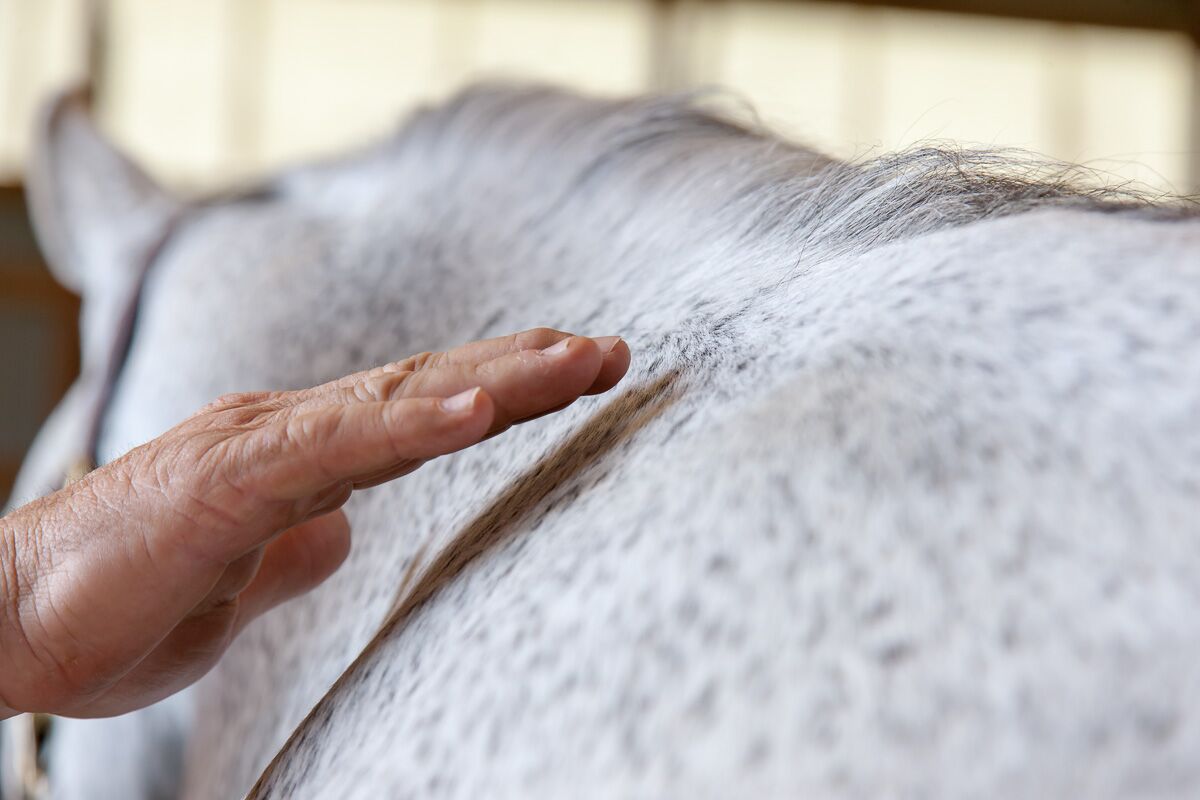
“It’s wonderful to see horses responding to light touch. They really get that we’re there to help them. Thank you, Jim Masterson, for developing this method, and Thank you to the team of teachers and practitioners for spreading the power.”
~ Lorraine Waite
“This is some amazing stuff! I purchased the light touch program and have been working with my horses with it. I swear, they seem to really like it and actually ‘ask’ for me to work on them. Plus, it’s fun and a great way to connect with your equine friends! I practiced with my stink-ear gelding and even he got some great releases.”
~ Joyce Hart
“I’ve just attended a two-day training clinic which was organized with in-depth, hands-on work. Since returning I have worked with my horse and seen some impressive results. It works like magic .. but is founded on solid horsemanship knowledge. Love it.”
~ Margaret Mitchell
“Dear Jim, I was watching your videos on YouTube, looking for some inspiration on how to proceed with a horse I bought recently. He’s an ex-trotter (pacer), newly gelded and about the most headshy horse I have ever come across. He was bought as a project and he does have a lot of good points which made me buy him, being very well put together and also very intelligent and very cheap!
Watching your video on how to deal with a headshy horse I laughed out loud because you couldn’t get that near Tom the Trotter’s head. Anyway there’s another unhandled horse on the yard which I used your methods on and they worked really well this morning,everything worked out just the way the video showed, so I had a go with Tom and I was really shocked. Before too long he was licking and yawning and lowering his head. In the end I could massage his atlas and axis vertebrae with his head just off the floor, his chosen position not mine! This horse would rather fling himself round the box hitting his head off the walls than let his ears be touched and was checked for teeth and back problems by two professionals.
My background as a registered British Horse Society Intermediate Instructor (since 1982) means I’ve seen an awful lot of different people doing a vast amount of different things to horses, from swinging crystals over horses to using rubber mallets on them and it makes me pretty sceptical. What Jim does is refreshingly quiet, non-theatrical and effective.
So thanks Jim, this may just be the break through Tom and I needed.”
~Best Regards, Kate Kelk
